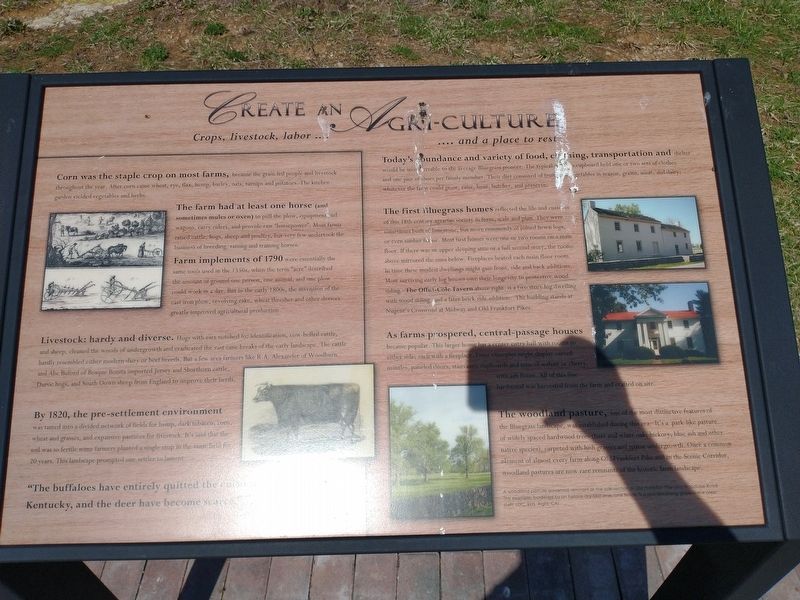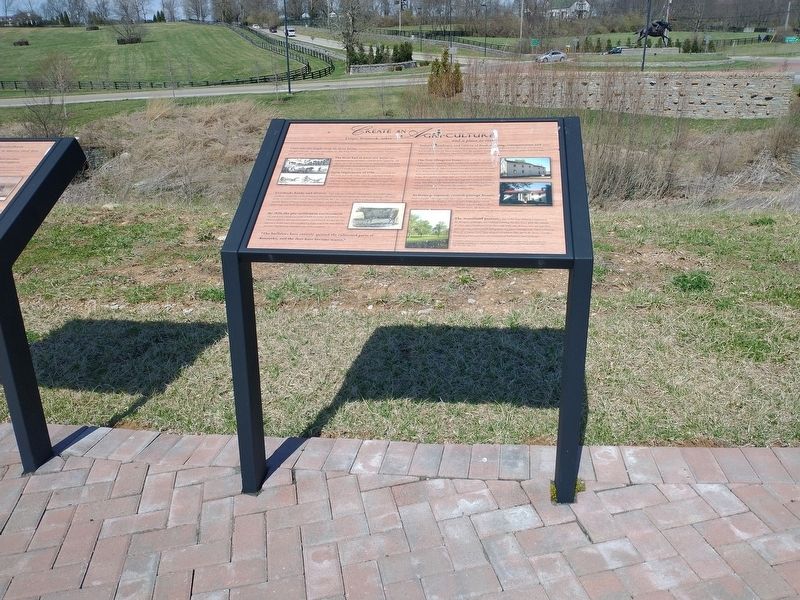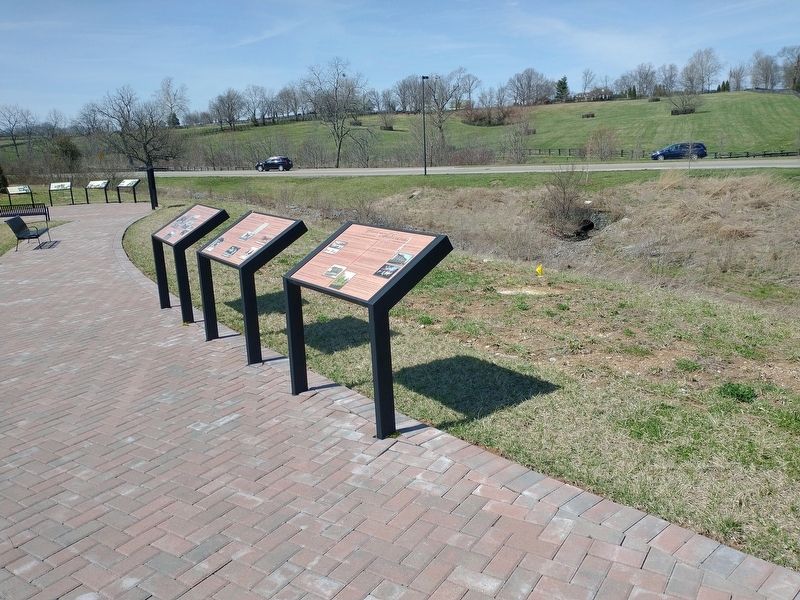Lexington in Fayette County, Kentucky — The American South (East South Central)
Create An Agri-culture
Crops, livestock, labor...and a place to rest
The farm had at least one horse (and sometimes mules or oxen) to pull the plow, equipment and wagons, carry riders, and provide raw "horsepower", Most farms raised cattle, hogs, sheep and poultry, but very few undertook the business of breeding, raising and training horses.
Farm implements of 1790 were essentially the same tools used in the 1550s, when the term "acre” described the amount of ground one person, one animal, and one plow could work in a day. But in the early 1800s, the invention of the cast iron plow, revolving rake, wheat thresher and other devices greatly improved agricultural production.
Livestock: hardy and diverse. Hogs with ears notched for identification, cow-belled cattle, and sheep, cleaned the woods of undergrowth and eradicated the vast cane breaks of the early landscape. The cattle hardly resembled either modern dairy or beef breeds. But a few area farmers like R.A. Alexander of Woodburn and Abe Buford of Bosque Bonita imported Jersey and Shorthorn cattle, Duroc hogs, and South Down sheep from England to improve their herds.
By 1820, the per-settlement environment was tamed into a divided network of fields for hemp, dark tobacco, corn, wheat and grasses, and expansive pastures for livestock, It's said that the soil was so fertile some farmers planted a single crop in the same field for 20 years, This landscape prompted one settler to lament...
"The buffaloes have entirely quitted the cultivated parts of Kentucky, and the deer have become scarce."
Today's abundance and variety of food, clothing, transportation and shelter would be inconceivable to the average Bluegrass pioneer. The typical settler's cupboard held one or two sets of clothes and one pair of shoes per family member. Their diet consisted of fruits and vegetables in season, grains, meat, and dairy; whatever the farm could grow, raise, hunt, butcher, and preserve.
The first bluegrass homes reflected the life and costumes of this 18th century agrarian society in form, scale and plan. They were sometimes built of limestone, but more commonly of joined hewn logs, or even timber frame. Most first homes were one or two rooms on a main floor. If there was an upper sleeping attic or a full second story, the rooms above mirrored the ones below. Fireplaces heated each main floor room. In time these modest dwellings might gain front, side and back additions. Most surviving early log houses owe their longevity to protective wood siding. The Offut-Cole Tavern above right, is a two story log dwelling with wood siding, and a later brick side addition. The building stands at Nugent's Crossroad at Midway and Old Frankfort Pikes.
As farms prospered, central-passage houses became popular. This larger home has a center entry hall with rooms to either side; each with a fireplace, Finer examples might display carved mantles, paneled doors, staircases, cupboards and trim of walnut or cherry, with ash floors. All of this fine hardwood was harvested from the farm and crafted on site.
The woodland pasture, one of the most distinctive features of the Bluegrass landscape, was established during this era. It's a park-like pasture. of widely spaced hardwood trees (burr and white oak, hickory, blue ash and other- native species), carpeted with lush grasses and sparse undergrowth. Once a common element of almost every farm along Old Frankfort Pike and in the Scenic Corridor, woodland pastures are now rare remnants of the historic farm landscape.
A woodland pasture (savanna) remnant at the intersection of Old Frankfort Pike and Woodlake Road. This example. bordered by an historic dry-laid limestone fence, is a rare remaining grove in the area. (Left: LOC, KHS. Right: CA)
Topics. This historical marker is listed in these topic lists: Agriculture • Settlements & Settlers. A significant historical year for this entry is 1790.
Location. 38° 4.125′ N, 84° 33.451′ W. Marker is in Lexington, Kentucky, in Fayette County. Marker is on Old Frankfort Pike, on the left when traveling east. Touch for map. Marker is in this post office area: Lexington KY 40502, United States of America. Touch for directions.
Other nearby markers. At least 8 other markers are within walking distance of this marker. Breed Only The Best (here, next to this marker); Gentlemen Farmers and Burley Tobacco (here, next to this marker); The Settlers (a few steps from this marker); Geology And The Land (a few steps from this marker); the International Thoroughbred Landscape (a few steps from this marker); Americas First West (a few steps from this marker); Calumet Farm (a few steps from this marker); The West Fayette County (a few steps from this marker). Touch for a list and map of all markers in Lexington.
Credits. This page was last revised on April 4, 2022. It was originally submitted on March 28, 2022, by Craig Doda of Napoleon, Ohio. This page has been viewed 185 times since then and 10 times this year. Photos: 1, 2, 3. submitted on March 28, 2022, by Craig Doda of Napoleon, Ohio. • J. Makali Bruton was the editor who published this page.


